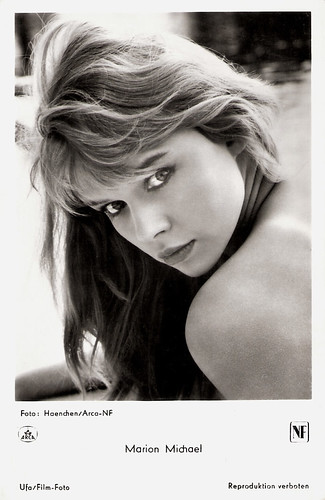
German postcard by Universum-Film Aktiengesellschaft (UFA), no. FK 3762. Retail price: 25 Pfg. Photo: Haenchen / Arca-NF. Marion Michael.

German postcard by Franz-Josef Rüdel, Hamburg-Bergedorf, no. 1858. Photo: Interwest / Union-Film / Haenchen. Horst Buchholz in Die Halbstarken/Teenage Wolfpack (Georg Tressler, 1956).

German postcard by Hans Josef Rüdel, Filmpostkartenverlag, Hamburg-Bergedorf, no. 2647. Photo: H.P. / Union / Haenchen. Conny Froboess, Rex Gildo, Richard Hellmann, Elke Arendt, Monika Leonhardt, Sergio Casmai and Hans Zander in Hula-Hopp, Conny (Heinz Paul, 1959).
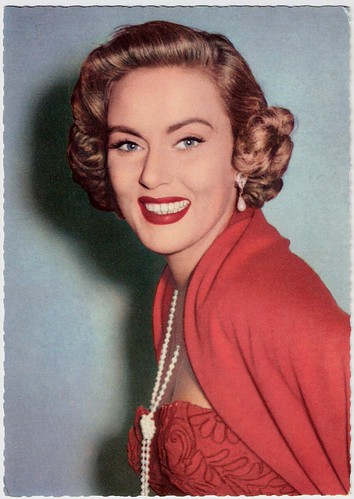
German postcard by ISV, no. M 13. Photo: Europa-Film / Haenchen. Nadia Gray.

Austrian postcard by Lichtbild-Vertrieb Paula Weizmann, Wien, no. F 7. Photo: Interwest / Union-Film / Haenchen. Karin Baal and Horst Buchholz in Die Halbstarken/Teenage Wolfpack (Georg Tressler, 1956).
One of the most important fashion photographers of his time
Karl Ludwig Haenchen or K.L. Haenchen or simply Haenchen was born in 1911 in Berlin. He grew up as the eldest of seven children of the grammar school teacher and historian Karl Haenchen and his wife Erna Haenchen, née Fruchtermann in Kleinmachnow near Berlin. He was the nephew of the theologian Ernst Haenchen.
He initially studied history and sports for the teaching profession but then turned to photography, in which he was self-taught. Around 1930, he opened his first photo studio in Berlin, where he was considered one of the most important fashion photographers of his time in the 1930s and 1940s.
At times he ran three studios simultaneously in Berlin. From 1932 his photographs also appeared in fashion magazines such as 'Elegante Welt' (from 1935), 'Die Dame' (1936-1942), 'Die neue Linie (1936-1939), 'Hella' (1936-1942) and 'NS-Frauen-Warte (1936-1944). An early colour photograph appeared as the cover of 'Die Dame' in 1942.
In accordance with the style of the time, the models often appear in Haenchen's works shot from below. In this way, he also photographed hundreds of Nazi soldiers.
After the end of the war, Haenchen initially produced mainly portraits. Later, he returned to fashion and press photos for 'Film und Frau' (from 1948), 'Inspiration', 'Die Zeitschrift für die Dame' (from 1950) and the illustrated magazine 'Stern' (1950-1955).
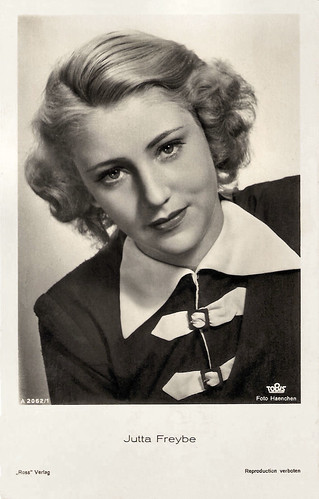
German postcard by Ross Verlag, no. A 2062/1, 1939-1940. Photo: Haenchen / Tobis. Jutta Freybe.
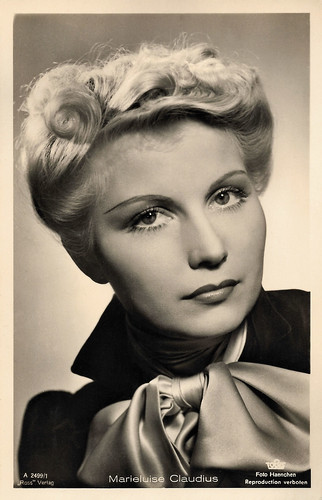
German postcard by Ross Verlag, no. A 2499/1, 1939-1940. Photo: Haenchen / Tobis. Marie Luise Claudius.
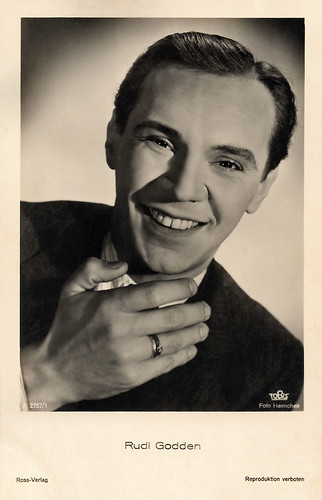
German postcard by Ross Verlag, no. A 2757/1, 1939-1940. Photo: Haenchen / Tobis. Rudi Godden.

German Postcard by Ross Verlag, no. A 3059/1, 1941-1944. Photo: Haenchen / Tobis. Ruth Hellberg.

German Postcard by Ross Verlag, no. A 3359/1, 1941-1944. Photo: Haenchen / Tobis. Hannelore Schroth.
The Aryan Haenchen
In 1938, the Nazi Labour Inspectorate closed Atelier Binder, the studio of famous photographer Alex Binder, who had died in 1929. After his death, Mrs. Binder-Allemann and their two daughters were the owners of the photography studio. The manager was the Jewish Elisabeth Baroness von Stengel and the first operator was probably the photographer Hubs Floeter. They were employed at the studio until 1938 and Elisabeth Baroness von Stengel was deported to the Theresienstadt concentration camp in 1943.
The Aryan Haenchen moved in in 1938 and continued to make celebrity portraits. His film portraits were published on star postcards by such publishers as Film-Foto-Verlag. After World War II, the Hasse und Wiese company took over the studio in 1948 or 1949. Karl Ludwig Haenchen continued to work as a star photographer for the film company Sascha / Tobis.
In 1954 he moved to Hamburg. In the early 1960s, he wrote and composed a number of pop songs, including 'Don't Turn Around' (1961, with Bobby Schmidt), 'Paris is Worth a Trip' (1961, with Jupp Schmitz) and 'Das Glücksrad' (1962, with lyrics by Kurt Feltz) which was featured in the film Das süsse Leben des Grafen BobbyThe Sweet Life of Count Bobby (Géza von Cziffra, 1962) with Peter Alexander and Ingeborg Schöner.
He directed the short television film Eine weiße Hochzeitskutsche/A White Wedding Carriage (Karl Ludwig Haenchen, 1964) with Maria Litto and Klaus Beelitz, and also worked as a television producer in 1966. From 1970 he was no longer active as a photographer.
Karl Ludwig Haenchen passed away in 2003 in Dolcedo-Castellazzo in Italy. In his first marriage, Haenchen was married to the fashion journalist Petra Fiedler, née Behrens, the eldest daughter of the architect Peter Behrens. From 1948 he was married to Ilse Haenchen, née Oeberg (1918-2019), with whom he had two sons.

German postcard by Ross Verlag, no. A 3370/2, 1941-1944. Photo: K.L. Haenchen. Carola Höhn.
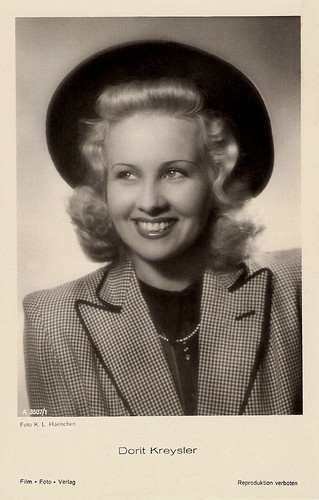
German postcard by Film-Foto-Verlag, no. A 3507/1, 1941-1944. Photo: K.L. Haenchen. Dorit Kreysler.
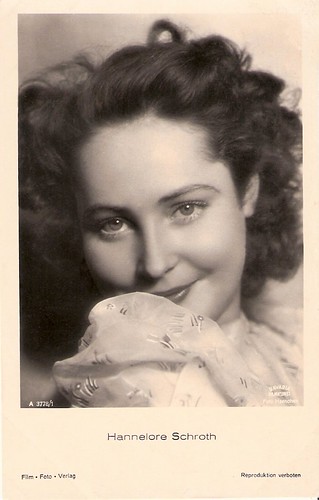
German postcard by Film-Foto-Verlag, no. A 3776/1, 1941-1944. Photo: Foto Haenchen / Bavaria Filmkunst. Hannelore Schroth.

German postcard by Kolibri-Verlag, Minden/Westf., no. 2329. Photo: Interwest / Union / Haenchen. Horst Buchholz and Karin Baal in Die Halbstarken (Georg Tressler, 1956).
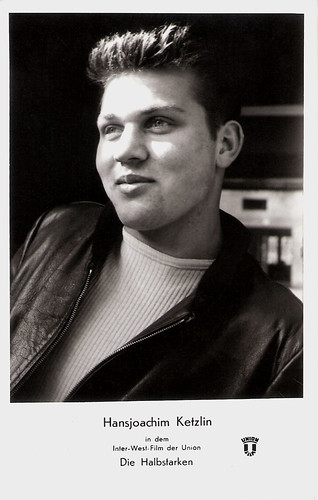
German postcard by Labaphot. Photo: Interwest / Union / Haenchen. Hansjoachim Ketzlin in Die Halbstarken (Georg Tressler, 1956).

German postcard by Rüdel-Verlag, Hamburg-Bergedorf, no. 1635. Photo: Real / Europa-Film / Haenchen. Renate Mannhardt in Die Ehe des Dr. med. Danwitz/Marriage of Dr. Danwitz (Arthur Maria Rabenalt, 1956).
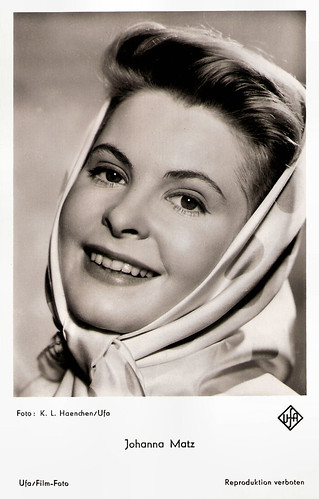
German postcard by Ufa, Berlin-Tempelhof, no. FK 4157. Photo: K.L. Haenchen / Ufa. Johanna Matz in Man müßte nochmal zwanzig sein/One would have to be twenty again (Hans Quest, 1958).

German postcard by Ufa, Berlin-Tempelhof, no. FK 4159. K.L. Haenchen / Ufa. Gerlinde Locker in Man müßte nochmal zwanzig sein/One would have to be twenty again (Hans Quest, 1958).
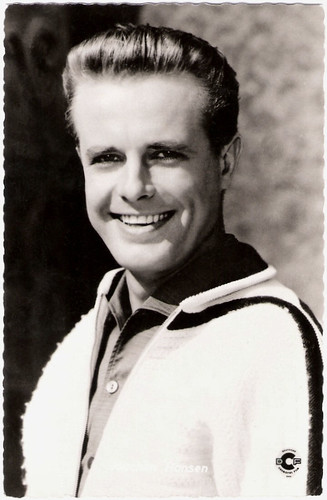
German postcard by Kolibri-Verlag G.m.b.H., Minden/Westf., no. 1071. Photo: Cinelux / Deutsche Cosmopol-film (DCF) / Haenchen. Joachim Hansen in Der Schatz vom Toplitzsee/The Treasure in Toplitz Lake (Franz Antel, 1959).
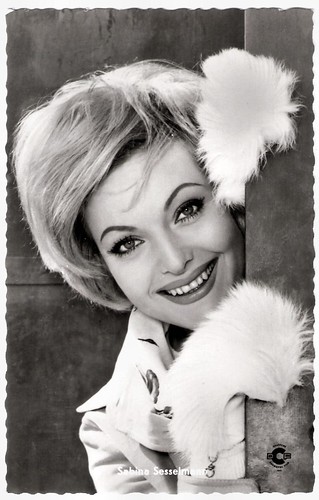
German postcard by Kolibri-Verlag G.m.b.H., Minden/Westf., no. 1112. Photo: Cinelux / Deutsche Cosmopol-Film (DCF) / Haenchen. Sabina Sesselmann in Der Schatz im Toplitzsee/The Treasure in Toplitz Lake (Franz Antel, 1959).
Sources: Wikipedia (German) and IMDb.
No comments:
Post a Comment